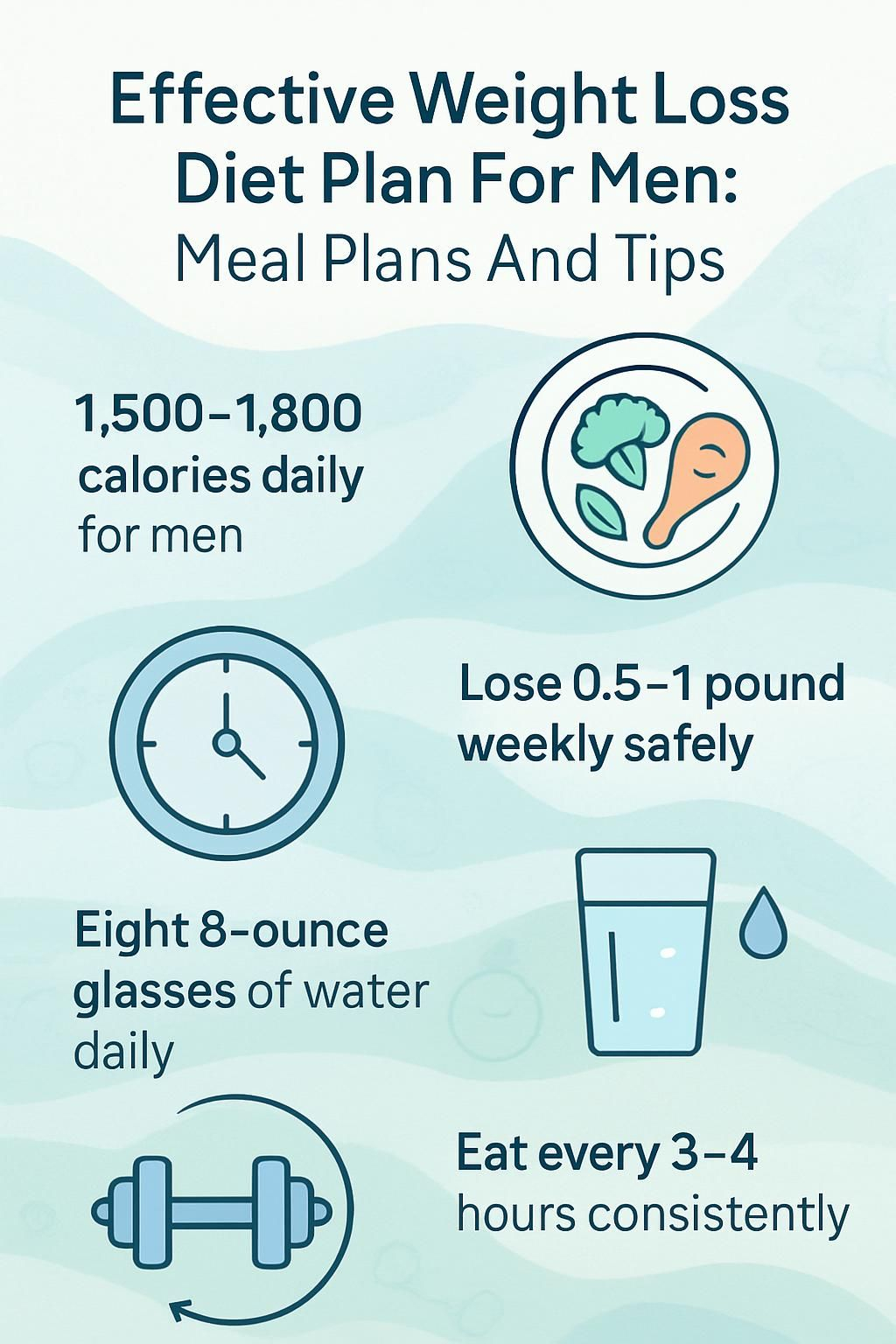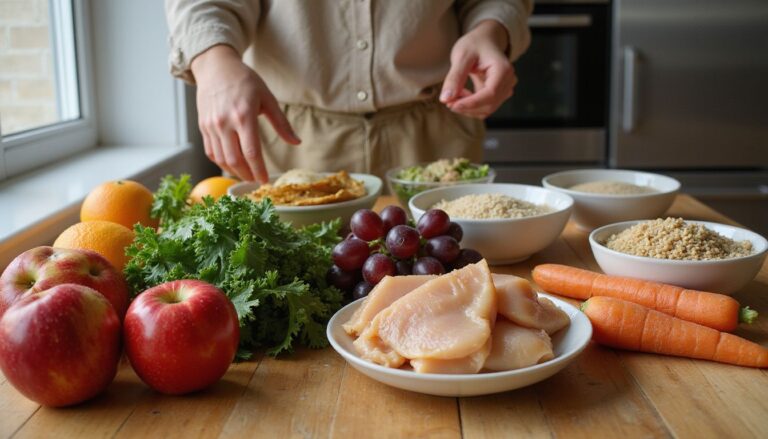Effective Weight Loss Diet Plan For Men: Meal Plans And Tips
Our Nutrition Assistant AI Suite will transform your body. You will lose fat, get toned, and build muscle. Gain confidence and optimal health.
Sticking to a strict diet yet seeing the same number on the scale can feel discouraging. A simple, structured weight loss diet plan can raise your chances of losing weight and help reduce risks like heart disease and diabetes. Clear steps and a realistic meal plan for men make progress easier to see and maintain.
In this guide, you get practical meal ideas, smart portion tips, and easy recipes that fit real life. Small changes stack up. With the right plan for men, you can build steady habits that support long-term weight management.
Key Takeaways
- Most men do well with 1,500–1,800 calories a day and a target loss of 0.5–1 pound per week for safety and consistency (Dietary Guidelines for Americans, Mayo Clinic Diet).
- Balanced plates with lean protein, whole grain options, fruits, vegetables, and healthy fats like olive oil support sustainable weight-loss and lower disease risk.
- Hydration matters. Aim for about eight 8-ounce glasses daily and limit processed foods, sugary drinks, fried snacks, and excess alcohol to stay in a calorie deficit.
- Meal timing every 3–4 hours and simple tracking tools, such as food journals or apps, improve adherence and long-term success.
- Pair calorie control with strength training and cardio. This combination increases fat loss and protects muscle mass.

Basics of Weight Loss for Men

Understanding a few core ideas will help you reach a healthy weight. Nutrition, daily calorie intake, and regular physical activity work together. With a simple plan, you can control portions, keep energy up, and move closer to your goals.
What Is a Calorie Deficit and Why Does It Matter?
A calorie deficit means you eat fewer calories than your body uses in a day. That gap leads to weight loss, as noted by the Dietary Guidelines for Americans and the U.S. Department of Health and Human Services. For example, if you eat 1,800 calories but burn 2,200, you create a 400 calorie deficit.
Safe progress is about 0.5 to 1 pound per week. This pace helps you avoid rebound weight gain and supports better habits. Many men do well on 1,500 to 1,800 calories a day. Very low-calorie diets, around 800 calories, can cause fast loss but should be done only with medical supervision.
I once cut calories too fast. The result was constant hunger and low energy. Slower, steady reductions made the plan easier to follow and improved my mood and workouts.
How Do Macronutrients Affect Weight Loss?
Macronutrients are the body’s main energy sources: carbohydrates, protein, and fat. A balanced approach, like the Mayo Clinic Healthy Weight Pyramid, focuses on nutrient-dense foods rather than cutting whole food groups.
For instance, a Mediterranean-style plate might include oats for carbohydrates, fish or chicken for protein, and olive oil for healthy fat. Portions such as 100 grams of fish, 65 grams of roast beef, or a 30 gram handful of nuts can help you hit daily goals.
Protein from yogurt, beans, or eggs helps you feel full longer, which can reduce snacking. Healthy fats from olive oil, walnuts, and fish support heart health and steady energy. Whole grains and high-fiber foods, like beans and vegetables, improve digestion and satisfaction.
Fad diets that remove major nutrients often cause low energy and fast regain. A balanced mix encourages variety, supports a healthy diet, and makes your weight loss plan more sustainable.
How Does Hydration Influence Weight Loss?
Hydration affects hunger, energy, and digestion. Drinking water before meals can reduce appetite and help prevent overeating. Beverages like coffee with milk can count toward fluid needs and contribute dairy servings.
Eating produce with high water content, such as berries, tomatoes, cucumber, and broccoli, boosts hydration and fiber. Higher fiber intakes require enough fluids to avoid digestive discomfort. Many adults do well with about eight 8-ounce glasses of water per day, which supports fat loss and a healthy body weight.
Key Components of an Effective Weight Loss Diet Plan
An effective weight-loss program focuses on smart food choices and simple routines. Balanced meals and consistent habits improve physical and mental health as you lose weight.
How to Achieve Balanced Nutrition for Weight Loss
Choose nutrient-dense foods from all food groups. Combine lean protein, complex carbohydrates, and healthy fats at each meal to stay full and energized. Examples include chicken or fish, oats or brown rice, and olive oil or nuts.
Fill half your plate with vegetables and fruits for fiber and vitamins, as promoted by the Mayo Clinic Diet and the Healthy Weight Pyramid. Include low-fat dairy, such as cottage cheese or yogurt, to support muscle while keeping calories in check.
Build meals with at least three major food groups. Focus on whole grains, colorful produce, and omega-3 fats from salmon or seeds. You can succeed without strict calorie counting by making balanced plates a daily habit.
What Are Proper Portion Sizes for Weight Loss?
Portion control keeps calories a day in range without complicated math. The Mayo Clinic Diet favors simple serving estimates. For example, breakfast could include 2 slices of whole grain toast as 2 grain serves, 1 cup baked beans as a vegetable serve, and 1 cup reduced-fat milk as a dairy serve.
Keep lean meats, like roast beef, around 65 grams per meal. Measure nuts as a 30 gram handful. Use visual guides, like the Healthy Weight Pyramid, to see how much of each food group fits your plan. A Mediterranean-style day might include one cup sliced peppers, one banana, and one cup mixed fruit through meals and snacks.
Enjoy small treats up to about 75 calories per day, spaced across the week. Thoughtful portions allow steady loss without cutting entire food groups.
When Should You Eat Meals and Snacks for Best Results?
Have breakfast within an hour of waking to stabilize appetite and energy. A schedule with breakfast, a morning snack, lunch, an afternoon snack, dinner, and an evening snack every three to four hours can prevent overeating.
Spreading treats through the week keeps cravings in check while you stay on track. Many dietitians agree that regular meals support steady energy, better focus, and more consistent progress. Next is a sample 1,500 calorie daily meal plan for men who are losing weight.
Sample Meal Plans for Men
Structured menus help you manage calories, plan shopping, and reduce guesswork. Here are simple options you can follow or swap with similar foods.
What Does a 1,500-Calorie Daily Meal Plan Look Like?
Breakfast: 2 slices whole grain toast with 2 teaspoons soft margarine, 1 cup baked beans, 1 fresh tomato, and 1 cup reduced-fat milk. Morning snack: 1 apple and 200 ml coffee with milk.
Lunch: Sandwich with 2 slices whole grain bread, 65 grams roast beef, 20 grams reduced-fat cheese, 1 cup mixed salad, and 2 teaspoons soft margarine.
Afternoon snack: 30 grams unsalted nuts and coffee with milk. Dinner: 100 grams fish cooked in olive oil, 1 cup boiled rice, 1 medium potato, 1 cup carrots, and 1 cup broccoli.
Evening snack: 1 cup fruit salad and 100 grams reduced-fat yogurt. This plan balances protein, whole grains, vegetables, and dairy while keeping portions clear.
How to Follow a 1,800-Calorie Daily Meal Plan
Use the same structure as above and increase portions slightly, or add a snack. Choose whole foods like vegetables, lean protein, and whole grains. Adjust servings of fruit, vegetables, or chicken if hunger rises.
The Mayo Clinic Diet supports flexible swaps as long as portions fit your target. Aim for three meals and one or two snacks to steady energy and appetite. I used this approach while jogging after work. Planning ahead helped me avoid ultra-processed items and soft drinks when busy.
These steps lower obesity risk factors. They also keep added sugar low while providing nutrients men need.
What Is an Example of a Weekly Meal Plan?
Breakfasts: Monday oatmeal with berries; Tuesday broccoli-feta omelet; Wednesday Greek yogurt with nuts; Thursday berry oatmeal; Friday poached eggs with avocado toast; Saturday smoothie; Sunday whole grain cereal with milk.
Lunches: Monday grilled chicken salad; Tuesday quinoa and vegetables; Wednesday salmon with leafy greens; Thursday turkey wrap; Friday vegetarian chili; Saturday grilled shrimp with brown rice; Sunday mixed bean salad.
Dinners: Baked chicken with roasted vegetables, tofu stir-fry with brown rice, or salmon with quinoa and spinach. The Mayo Clinic Diet allows a small daily dessert up to 75 calories to support consistency.
Use a food journal and weight tracker during the LIVE IT! phase to plan ahead and monitor progress week to week.
Foods to Include in a Weight Loss Diet
Choosing nutrient-dense foods makes it easier to create a calorie deficit while staying satisfied. Mediterranean diet patterns offer a helpful blueprint with simple ingredients and clear portions.
Which High-Protein Foods Aid Weight Loss?
Helpful options include fish, lean beef, chicken, yogurt, eggs, and beans. A 100 gram serving of fish or yogurt provides lean protein for muscle support and fullness.
Roast beef at 65 grams and reduced-fat cheese at 20 grams add variety without too many calories. Unsalted nuts such as almonds or pumpkin seeds supply protein and healthy fats. Meals centered on these foods keep you full, so daily calorie intake stays in check. I noticed that adding black beans at lunch cut afternoon snack needs.
Mediterranean-style plans often include salmon, chicken, and white beans. Intermittent fasting plans can use eggs or Greek yogurt at breakfast for steady energy and appetite control.
What Whole Grains and Fiber-Rich Foods Should You Eat?
Choose whole grains like whole grain toast, brown bread, oats, quinoa, and boiled rice. These foods are mainstays in the Mayo Clinic Diet and Mediterranean meal plans.
Two slices of whole grain toast in the morning and two at lunch or dinner can fit into your daily plan. Oats work well for overnight oats or hot cereal and keep you full. Boost fiber with baked beans and vegetables such as broccoli, carrots, and leafy greens. The U.S. Department of Agriculture encourages several servings of fruits and vegetables each day for digestive health.
Starting the day with whole grain toast often helps prevent cravings for sweet drinks or convenience snacks. A plant-forward plan makes it easier to reduce calories and build habits that support heart and metabolic health.
Which Healthy Fats and Omega-3 Sources Are Best?
Olive oil is a heart-healthy choice for cooking and dressings. Salmon is rich in omega-3 fatty acids, which support heart health and may reduce inflammation.
Add unsalted nuts, like almonds or walnuts, for fullness and flavor. A 30 gram portion is a sensible serving. Soft margarine with polyunsaturated fats can be used in small amounts. Seeds such as chia or flax raise omega-3 intake, especially in vegetarian plans.
Focus on fatty fish and plant oils while limiting saturated fats like palm oil or excess red meat. This pattern helps manage weight and lowers risk for heart attack or stroke.
What Fruits and Vegetables Support Weight Loss?
Choose produce that is high in water, low in calories, and rich in fiber. Examples include apples, tomatoes, mixed salads, carrots, broccoli, berries, and simple fruit salads.
Snack on one cup of sliced bell peppers or grab a banana for quick energy. The Mayo Clinic Diet places fruits and vegetables at the base of the Healthy Weight Pyramid because they increase fullness without many calories.
Your body may need time to adjust to higher fiber, which can cause some gas at first. Focusing meals on whole plant foods helps control calories and limits the pull of salty or fried snacks like French fries.
Foods to Avoid or Limit
Some foods make staying in a calorie deficit tough. Cutting back on them can speed progress and protect your health.
Why Should You Avoid Processed and Ultra-Processed Foods?
Processed and ultra-processed foods often pack extra calories, sodium, and added sugar. They may cause you to eat more without feeling satisfied. This pattern makes steady loss harder and raises long-term disease risk.
The Mayo Clinic Diet, especially during LOSE IT!, encourages reducing these foods to build better habits. Many meal replacements, shakes, or bars rely on ultra-processed ingredients. They can help short term but rarely support lasting health.
Choose whole grains, lean protein, and produce whenever possible. You may feel fuller on fewer calories, with fewer blood sugar spikes. This approach supports weight management and better nutrition.
How Do Sugary Beverages and Desserts Affect Weight Loss?
Sugary beverages such as soda and juice add calories without fullness. This makes it harder to maintain a calorie deficit. Replace them with water, unsweetened coffee, or tea to reduce intake and improve hydration.
Limit desserts to 75 calories per day and spread them through the week. The Mayo Clinic Diet favors moderation, which helps manage cravings while you work toward long-term goals. Lowering high-sugar foods also supports healthy blood pressure.
What Are the Risks of Fried and High-Calorie Snacks?
Fried foods and rich snacks often contain a lot of calories and unhealthy fats. A single serving can exceed 300 calories. That adds up quickly and can erase your daily deficit.
Diets high in these foods raise heart disease risk and can harm blood pressure. Swap fried items for grilled, roasted, or baked choices. During my own cut, replacing chips with raw nuts or sliced vegetables kept me satisfied with fewer calories.
Snack smarter with fruit, vegetables, or a small handful of nuts. Lowering these foods supports portion control and makes progress more consistent.
How Does Excessive Alcohol Impact Weight Loss?
Alcohol has 7 calories per gram, close to fat. Many drinks also contain sugar. A 12-ounce beer is about 150 calories, and a glass of wine can be 120 or more. These calories add up fast and offer little nutrition.
Excess drinking makes a calorie deficit harder to reach and can slow fat burning. I dropped several pounds faster after skipping weekend drinks. If alcohol derails your plan, talk to your doctor and set limits that fit your goals.
Popular Diet Strategies for Weight Loss
Different approaches work for different people. The best diet plan is one you can follow, supports health, and fits your routine.
What Are Low-Calorie Diets (LCD) and How Do They Work?
Low-Calorie Diets for men usually target 1,500 to 1,800 calories a day, which is below typical needs. Some plans include meal replacements like shakes or bars to simplify choices. Health professionals often oversee these plans to ensure safety, especially if weight loss is quick.
LCDs can lead to about 1 to 2 pounds lost per week. High-protein foods like eggs, fish, or nuts help you feel satisfied and support activity like walking or swimming. Using meal planning apps to track foods and portions can make staying on plan easier.
How Does Intermittent Fasting Support Weight Loss?
Intermittent fasting alternates between eating and fasting periods. The 5:2 method uses two low-calorie days per week and five regular days. Many men find eating less often reduces total calories and increases focus on quality foods.
During fasting periods, the body uses stored energy, which can increase fat loss. Some people see early results in the first few weeks. In my case, fasting windows helped me make better choices at mealtimes and reduced stress about constant planning.
What Is the Mediterranean Diet and Its Benefits?
The Mediterranean diet emphasizes fish, whole grains, fruits, vegetables, legumes, and olive oil. A 1,200 calorie day might include overnight oats with berries, a white bean soup, and sheet-pan roast chicken with vegetables. Small treats like dark chocolate can fit in moderation.
Experts view this plan as practical and enjoyable, and the Mayo Clinic Diet often uses its principles. Many men report steady energy and better digestion. Over time, this pattern can help lower blood pressure and support heart health.
How Does Time-Restricted Eating Affect Weight Loss?
Time-restricted eating limits daily food to a set window, such as 8 hours, with fasting for the remaining 16 hours. This method can create an easy calorie deficit and reduce late-night snacking.
Some studies report weight losses of 2 to 4 kilograms in about 12 weeks. Long-term research is growing, but many people like the simplicity. I found that eating between noon and 8 p.m. reduced evening hunger and cut mindless snacking. Focus on balanced meals with protein, whole grains, fruits, and vegetables during the eating window.
Next, see quick recipes that make sticking to your plan simpler.
Simple and Easy-to-Prepare Recipes
Short on time? These recipes use common ingredients, simple steps, and support your daily calorie goals.
How to Make Chicken and Vegetable Stir-Fried Rice
Slice 100 grams chicken breast or a similar amount of white fish. Heat 1 tablespoon olive oil in a nonstick pan on medium. Cook the protein until done, then set aside.
Add chopped broccoli, carrots, bell peppers, and snap peas. Stir-fry 3 to 5 minutes until crisp-tender. Add 1 cup cooked rice and the protein, then toss for 2 minutes. Season with low-sodium soy sauce or spices.
This dish combines lean protein, whole grains, healthy fats, and fiber-packed vegetables. I like it on busy nights because it takes under 20 minutes and keeps me full.
What Is a Healthy Broccoli Feta Omelet Recipe?
Whisk two eggs. Sauté 1 cup chopped broccoli in a nonstick pan with a light spray of olive oil for 3 minutes. Pour in the eggs and sprinkle 20 grams reduced-fat feta.
Cook on medium, lifting edges so uncooked egg flows underneath. Fold and cook 1 more minute. Serve with sliced carrots for extra fiber. This meal offers protein, vegetables, and calcium in one pan.
How to Prepare Quick Berry Oatmeal
Combine 1/2 cup old-fashioned oats with 1 cup low-fat milk or water. Stir in 1 teaspoon chia seeds and 1/2 cup mixed berries. Add a pinch of cinnamon if you like.
Refrigerate overnight. In the morning, top with sliced pears or a few nuts for crunch. It is filling, easy, and fits your weight loss plan.
What Is a Simple Grilled Salmon with Quinoa and Vegetables Recipe?
Season a 4-ounce salmon fillet with lemon, pepper, and herbs. Grill about 5 minutes per side until cooked through. Cook 1/2 cup quinoa in water or low-sodium broth.
Steam broccoli, carrots, or green beans. Salmon provides about 23 grams of protein per serving plus omega-3s. Quinoa supplies fiber and steady energy. This meal keeps you satisfied while supporting a nutritious diet.
How to Make Poached Egg and Avocado Toast
Toast 1 slice whole grain bread. Mash half an avocado and spread it on the toast. Poach 1 large egg in simmering water for about 3 minutes and place it on top.
Add a pinch of salt and pepper. Whole grains add fiber, eggs supply protein, and avocado provides healthy fats. Prep time is under 10 minutes, and the meal holds you through the morning.
The Role of Exercise in Weight Loss
Exercise helps you burn calories and keep muscle. It also improves mood and sleep, which supports your eating plan.
How Does Strength Training Build Muscle and Aid Weight Loss?
Strength training uses resistance, such as weights or bodyweight moves, to build muscle. Muscle tissue raises your resting metabolic rate. That means you burn more calories even while sitting.
Research suggests each pound of muscle burns several calories per day at rest, more than fat tissue. This supports long-term loss and better body composition. The Mayo Clinic Diet includes resistance routines for better results.
Check with a healthcare provider before starting if you have heart or joint issues. I saw progress by lifting twice a week. My energy rose, and clothes fit better within two months.
What Cardiovascular Workouts Burn Fat Effectively?
Cardio raises your heart rate and helps your body use stored fat. Brisk walking, running, cycling, and swimming are all effective. Even 30 minutes of moderate walking daily can help.
Experts suggest at least 150 minutes of moderate cardio or 75 minutes of vigorous cardio weekly. Mix routines to keep them interesting, like walking with intervals of light jogging. Variety supports steady progress and heart health.
How to Incorporate Daily Activities Like Walking and Jogging?
Take stairs, park farther away, and walk to nearby stops to add movement. Aim for at least 30 minutes of moderate activity each day. Brisk walking and easy jogging are simple ways to burn calories.
Start small, like a 10-minute walk after lunch. Track steps with a phone or watch. Many people see better energy and reliable loss within weeks once these habits stick.
Tips for Long-Term Success
Lasting change happens with clear goals, steady tracking, and flexible tools. Small wins build confidence and keep your plan moving forward.
How to Set Realistic Weight Loss Goals?
Choose goals that fit your lifestyle and health status. The Mayo Clinic Diet suggests a safe rate of 1 to 2 pounds per week. Use the LIVE IT! phase to build habits that help maintain your target weight.
Break big goals into smaller milestones, such as the first 5 pounds. Track both habits and weight changes so you can see progress even when the scale is slow.
What Are Effective Ways to Track Progress and Adjust Plans?
Use a simple food and exercise journal or a weight tracker. The Mayo Clinic Diet includes tools that help you log meals and workouts. Weigh in at the same time each week and look at trends over several weeks.
Adjust your meal plan or activity if progress stalls. Review logs during the LIVE IT! phase to replace unhelpful habits with better choices.
How Can You Stay Motivated and Consistent?
Many men see a quick boost in the LOSE IT! phase, often 6 to 10 pounds in two weeks. Early results build momentum. Planning meals ahead and scheduling activity helps you stay consistent.
I set one small daily goal, like cooking a healthy dinner. Those small wins added up and kept me engaged. Choose enjoyable foods and routines so habits stick with less stress.
Why Avoid Fad Diets or Extreme Measures?
Very strict plans often slash calories too far. You may lose weight fast, then regain it as the body resists. Rapid cuts can reduce muscle and affect hormones, which hurts long-term success.
Safe progress is about 0.5 to 1 pound per week. Skipping meals or banning food groups raises health risks. Balanced meals and steady habits usually work better and last longer.
Potential Health Benefits of Weight Loss
Reaching a healthier weight can improve daily life in many ways. Better numbers at your checkups can also motivate you to keep going.
How Does Weight Loss Reduce Heart Disease Risk?
Losing weight lowers blood pressure and improves cholesterol. Even a 5% to 10% drop in body weight can help. A healthy eating plan plus regular activity reduces risk for coronary disease and stroke.
The Mayo Clinic Diet notes that healthy loss can also help prevent diabetes and sleep apnea. After I lost 12 pounds, my blood pressure and LDL cholesterol decreased. Smaller portions and more vegetables made a big difference.
What Improvements in Blood Sugar Levels Can Occur?
Weight loss often improves blood sugar control, especially with prediabetes or type 2 diabetes. A 5% to 10% reduction can lower fasting glucose and improve A1c, a two to three month average of blood sugar.
Balanced meals support better insulin sensitivity, so your body handles carbs more smoothly. Many people notice fewer spikes after meals and steadier energy through the day.
How Does Weight Loss Enhance Mental Health and Energy?
Healthy eating and exercise can reduce stress and raise energy. Plans like the Mayo Clinic Diet are practical, which supports a positive mindset and steady routine.
After dropping extra pounds, I felt lighter and more motivated to move. People who keep healthy routines often sleep better and feel more confident. Whole foods and regular movement can make daily tasks feel easier.
Why Does Weight Loss Lower Blood Pressure?
Extra body fat increases strain on your arteries. Losing weight reduces that strain, so vessels can relax. Harvard Health reports systolic blood pressure may drop about 1 mm Hg for each kilogram lost.
Eating more vegetables, fruits, and healthy fats helps too. The Mediterranean diet aligns well with these goals and supports cardiovascular health. I saw lower readings after losing 10 pounds, without changes to medication.
Possible Challenges and How to Overcome Them
Setbacks are normal. With a few tools and a calm plan, you can work through them and keep going.
How to Manage Cravings and Emotional Eating?
Identify triggers like stress, boredom, or fatigue. Shift your attention to a quick walk, music, or a phone call. Eating more fiber-rich foods, such as beans, oats, and berries, increases fullness and can reduce snacking.
Use structured plans from LOSE IT! to replace late-night habits. Keep ready-to-eat options like cut vegetables or Greek yogurt. I swapped bedtime chips for sliced apples and noticed fewer overeating episodes.
What Strategies Help Stay Committed During Plateaus?
Track details closely to see wins beyond the scale, such as waist size, step counts, or reps lifted. Adjust calorie goals, meal ideas, or workouts every week or two if progress stalls.
The Mayo Clinic Diet Online suggests adopting five new helpful habits during a plateau. I joined an online support group for men and found it easier to stay on track, share hurdles, and celebrate small victories.
How to Balance Diet With a Busy Lifestyle?
Busy schedules can still support a healthy diet. The Mayo Clinic Diet uses two phases to fit real life. LOSE IT! jump-starts progress. LIVE IT! builds lasting habits with flexible meal planning.
Stock easy foods like salad kits with grilled chicken, Greek yogurt with fruit, or overnight oats. During heavy work weeks, I kept containers of cut vegetables and nuts for quick snacks. Meal prep on one or two days helps you avoid last-minute fast food. Aim for 1 to 2 pounds per week and check with your healthcare provider for safety and personal needs.
The Role of Technology in Weight Loss
Technology can simplify tracking, planning, and motivation. A few minutes of logging each day can improve accuracy and results.
Which Apps Help Track Calories and Workouts?
Apps such as MyFitnessPal, Lose It!, and Cronometer let you log meals, scan barcodes, and track calories quickly. Many sync with devices like Fitbit or Apple Watch, so your steps and workouts update automatically.
Exercise apps, including Strava and Nike Training Club, show progress graphs and guide workouts. Logging helped me spot hidden snack calories and keep intake steady.
What Online Resources Assist With Meal Planning?
Websites like MyFitnessPal, Eat This Much, and Mealime build meal plans based on calorie targets and preferences. You can view nutrition for each recipe and swap ingredients to match what you have.
Recipe blogs such as Skinnytaste offer clear, step-by-step guidance. Forums and support groups provide feedback from people working on similar goals. Planning tools made my grocery trips faster and kept my plan on track.
How Can Wearable Fitness Devices Support Weight Loss?
Wearables track steps, calorie burn, heart rate, and activity in real time. Set daily targets and use reminders to move after long sitting periods.
Goal streaks and progress reports keep you accountable. Many devices sync with nutrition apps so you can compare calories eaten with calories burned. These features make it easier to spot patterns that slow progress and adjust sooner.
Using technology helps build active habits all week and supports a consistent eating plan.
Conclusion
Choosing an effective weight loss diet plan for men does not have to be complicated. Focus on balanced plates, portion control, and regular activity to see steady results. Simple tracking and planning tools make daily choices easier.
The Mayo Clinic Diet framework promotes healthy habits without strict counting, which helps you stick with your meal plan. Small adjustments in food and movement, repeated day after day, can help reduce your risk of chronic disease and improve health. Talk with your doctor if you have medical conditions or take prescriptions. Set clear goals, stay patient, and celebrate each step forward.
FAQs
1. What are the key parts of an effective weight loss diet plan for men?
A strong weight loss diet plan for men includes balanced meals with lean protein, whole grains, fruits, and vegetables. It limits added sugars and processed foods. Studies show that eating more fiber and protein can help control hunger and support fat loss.
2. How many calories should a man eat daily to lose weight?
Most adult males need about 1,500 to 1,800 calories per day to lose weight safely, depending on age, size, and activity level. Research from the National Institutes of Health suggests reducing daily intake by 500 calories can lead to about one pound of fat loss per week.
3. Can meal planning improve results in a weight loss program?
Meal planning helps control portions and reduces unhealthy food choices. A recent study found that people who planned their meals lost more fat than those who did not plan ahead.
4. Are there tips to make sticking to a meal plan easier?
Simple steps like preparing food in advance, keeping healthy snacks ready, and tracking progress each week make it easier to follow a meal plan. In my own experience, writing down what I eat helped me stay focused on my goals.
Summary: A successful fat reduction program for males uses balanced nutrition, calorie control, careful planning, and practical habits to support lasting results. Data supports these methods as both safe and effective for long-term health improvement.







